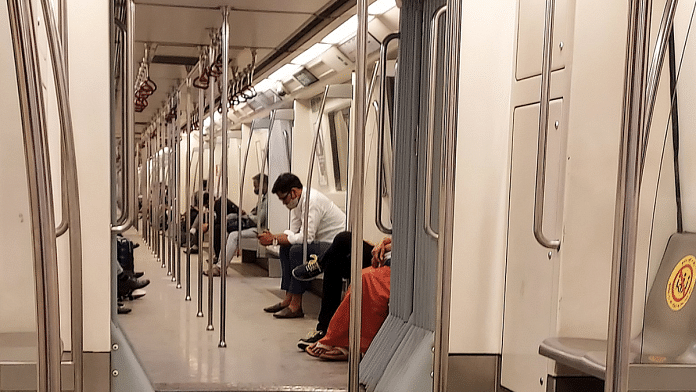While traffic and congestion on New Delhi roads often provoke the ire of commuters in the city, now overcrowded metros are becoming a catastrophe in waiting. New Delhi is expected to become the world’s largest agglomeration with a staggering population of 37.2 million people by the year 2028, according to a survey. Indians in the capital city are gravitating towards the metro, which is the most commonly used mode of public transport.
Today, the New Delhi metro faces an ever-growing ridership, with over 2.5 million passengers who rode daily in 2022. Commuters often complain, as the space to move around in trains during peak hours is rapidly shrinking. “We do not deserve to feel as if we’re travelling like cattle in jam-packed metros day in and day out,” complained a fuming commuter, elbowing his way out of a Yellow Line coach of the Delhi Metro Rail Corporation (DMRC).
The New Delhi metro began its first services on the Shahdara-Tis Hazari Red Line in December 2002 and has expanded its network across the length and breadth of New Delhi and the National Capital Region (NCR), from 8km to 380km between 2002 and 2021.
Commuter etiquette on New Delhi’s metro
Recently, the New Delhi metro authorities launched a campaign against customers who sit on the floor while riding in its trains. However, deploying patrols, repeated appeals and even the threat of punishment seem insufficient to convince passengers to abide by the guidelines set forth by the DMRC. So New Delhi must start looking at solutions that involve redesigning space in metros by adopting folding seats, double-decker metros and wider standing space.
A group of passengers from Noida were exasperated that “when people sit on the floor, they hinder other passengers’ ability to move to other coaches or even obstruct those trying to enter the metros”. They complained about the violation of fundamental commuter etiquette. “People can trip over the legs of these seated passengers, which is risky. Moreover, one person sitting on the floor takes the space where two to three people who could stand.”
Metro modernization
Modernizing trains built to meet smaller passenger rates, expanding and improving existing networks, combined with modernization of signalling systems and rolling stock, are some solutions where private sector investment can be of particular help.
For instance, Israeli Railways have introduced standing carriages as part of efforts to reduce overcrowding in their local trains. The new strategy, which falls within the “suburban travel” pilot project, will feature folding seats and handles, while regular seats and tables will be dismantled from the floor.
Another example is that of the Tokyo metro, which is the fastest tube across the world. Japan has set the gold standard for railway networks and speedy, hassle-free services for the daily commute in its capital city. The Tozai Line, linking the city’s business hub to the suburb of Chiba, is the most crowded. A government report cited that Tozai metro line has a 199% congestion rate (where 100% congestion rate means there are no free seats, and 199% is nearly double that capacity).
Off-peak metro incentivization schemes
In an effort to alleviate such overcrowding, Tokyo metro recently made international headlines when it started giving commuters free food coupons for staple Japanese dishes like soba noodles and tempura in local restaurants to those who use pre-peak hour trains for 10 consecutive days. New Delhi can try to adopt similar incentivization schemes to tackle the unbearable congestion in morning peak-hour trains.
New Delhi can try to adopt similar incentivization schemes to tackle the unbearable congestion in morning peak-hour trains. Given present trends in a developing economy like New Delhi, passenger and freight activity is undoubtedly going to double by 2050. While on one hand, this growth is a sign of social and economic progress, but it also carries with it greater energy demand and increased carbon emissions. Vehicle emissions are the biggest contributor towards air pollution. By switching to electric vehicles and public transport, auto-makers in India are being forced to decarbonize the transportation sector in its entirety.
Upscaling public transport
The government of New Delhi is also making efforts to upscale the overall public transport system and to augment the electric bus fleet. The capital outlay under this initiative amounts to INR 285 billion (28,556 crore Indian rupees) to deploy electric buses; INR 35 billion (3,500 crore) to improve New Delhi’s public transport system; INR 15 billion (1,500 crore) for electrification of 57 bus depots; 1,600 new electric buses; 900 EV charging points; 1,400 bus queue shelters, with digital screens that will display bus schedules; and the Mohalla bus scheme to ensure last-mile connectivity. This latter scheme involves three inter-state bus terminals with airport-like facilities in New Delhi. Taking these steps towards public transport and transport electrification can stem the New Delhi’s air pollution challenge.
Along with a robust policy thrust, the government should integrate a mixture of different schemes prioritizing lower emissions, not just the adoption of a single scheme. The recently launched One Delhi app, encourages greater use of public transport, including the metro. It facilitates the establishment of quality, focused multi-modal public transport systems that are well-integrated, providing seamless travel. Some of its key features are information about bus routes and bus stops, contactless e-ticketing, and locating electric vehicle chargers and battery-swapping stations.
With multiple lines, hundreds of stations, thousands of kilometres of tracks and millions of users, getting New Delhi metro trains to run on time all the time is a tall order. The right set of policy actions can help leverage large-scale private investment in this vital sector and prevent unnecessary service disruptions, making the metro a lifeline for New Delhi residents.
The views expressed in this piece are the author’s own and not representative of FICCI as an organization.
This article was originally published in the World Economic Forum.
Also read: Indian libraries are dying spaces. Govt will bring a festival to make reading cool



